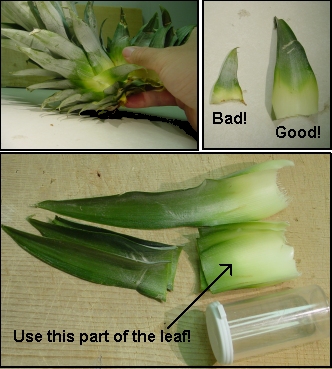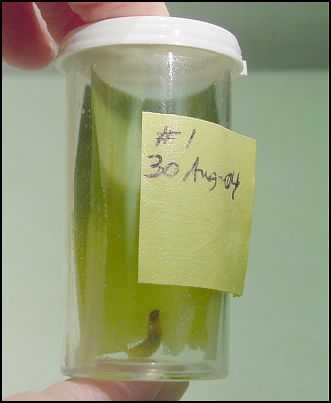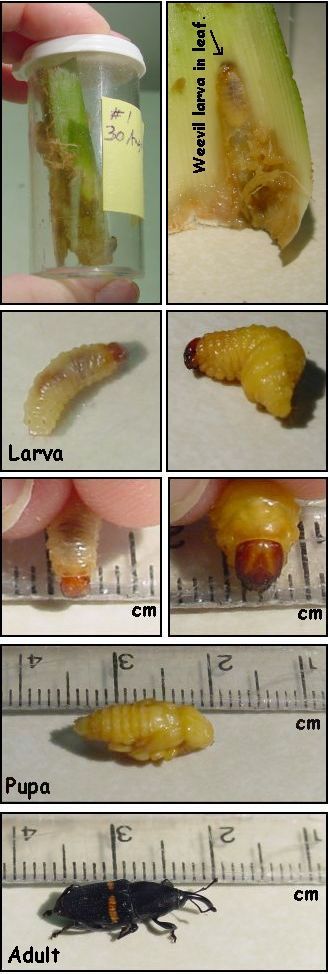How to Rear the Weevil
Instructions on Rearing the Weevil, Metamasius callizona, from Larva to adult
Instructions on Rearing the Weevil, Metamasius callizona, from Larva to adult

Larvae specimen
5 dram Vials
Labeling tape
Ruler
Lab notebook
Pineapple tops (can be provided from your local Publix supermarket)
Microscope (if possible, but not necessary)
To be used by an adult ONLY:
Cutting board and knife

Use the stiff, succulent leaves to feed the weevil. Discard the leaves on the outer round of the pineapple top because they are too small, hard and dry. Discard the leaves that make up the very core, because they are too soft and not well-formed yet.
Have an adult cut the pineapple leaves approximately 4 cm long from the base. Discard the tips and use the base portion of the leaves.
Left-over leaves can be kept in a plastic baggie or container and refrigerated.

Put one larva in the vial.
***CAUTION! CAUTION!***
Never put two larvae together in the same container - they are cannibals and one will eat the other!
Securely snap lid onto top of vial.
Put a piece of labeling tape on the vial with the larva's number and the date that you put it in there.
Record this information in your notebook.

***BUG JOKE***
***CAUTION! CAUTION!***
If a vial has an adult weevil, make sure the slit is a straight line across the top, like in the image. If it is a punctured hole, the weevil can chew its way out and escape!

Small larvae will burrow in the leaves. Make sure you look carefully for them!
As the weevil larva grows, it will get bigger and bigger. In order to get bigger, the larva must shed it's skin every now and then; this is called MOLTING. Sometimes when the insect molts, you can find the whole skin. Usually, however, you can only find the skin that covered the head (called the HEAD CAPSULE), because this is the hardest, most durable part of the skin.
When you change the pineapple leaves, look for the head capsule. When you find it, record the date in your notebook.
To measure how big the larva is growing, you can use the ruler to measure the head capsule. The body of the larva is squishy and will change length from second to second as the larva wiggles about, so it does not make a good estimate of the larva size.
Record the head capsule sizes in your notebook.
The larva molts five times, then it becomes a PUPA. As a pupa, the insect seems to be very still and not doing anything. But inside, the pupa is going through great transformations to become an adult.
If the larva made a cocoon to pupate in, remove it from the cocoon and keep it in a clean, dry vial. Check it daily to the see the changes that are occuring.
The pupa will molt once. You will be able to see the shed skin, and a shiny new adult when this happens.
In your notebook, record the times that the larva molted; when the insect began pupation; and when the adult emerged. Include anything else in your notebook that you thought was cool or interesting, and feel free to draw pictures.
Remember, this is a class notebook, and you'll be passing it on to next year's class, to learn from and to build upon your experiences.
Have fun!